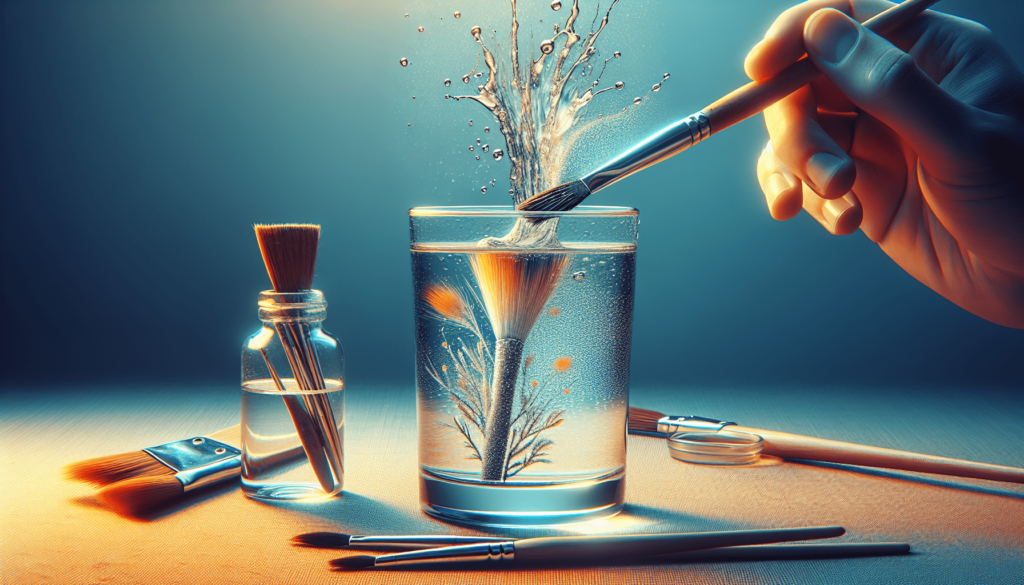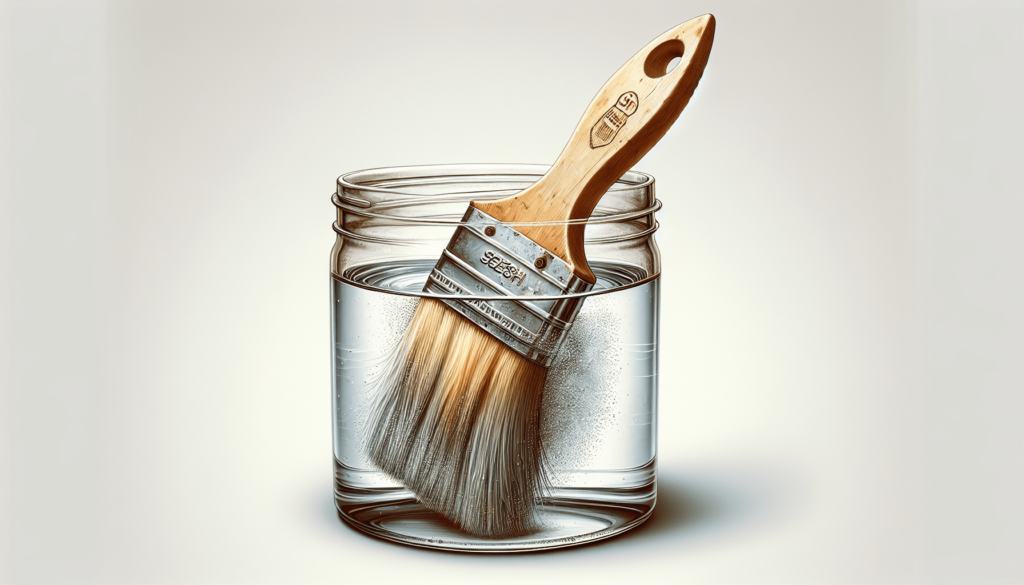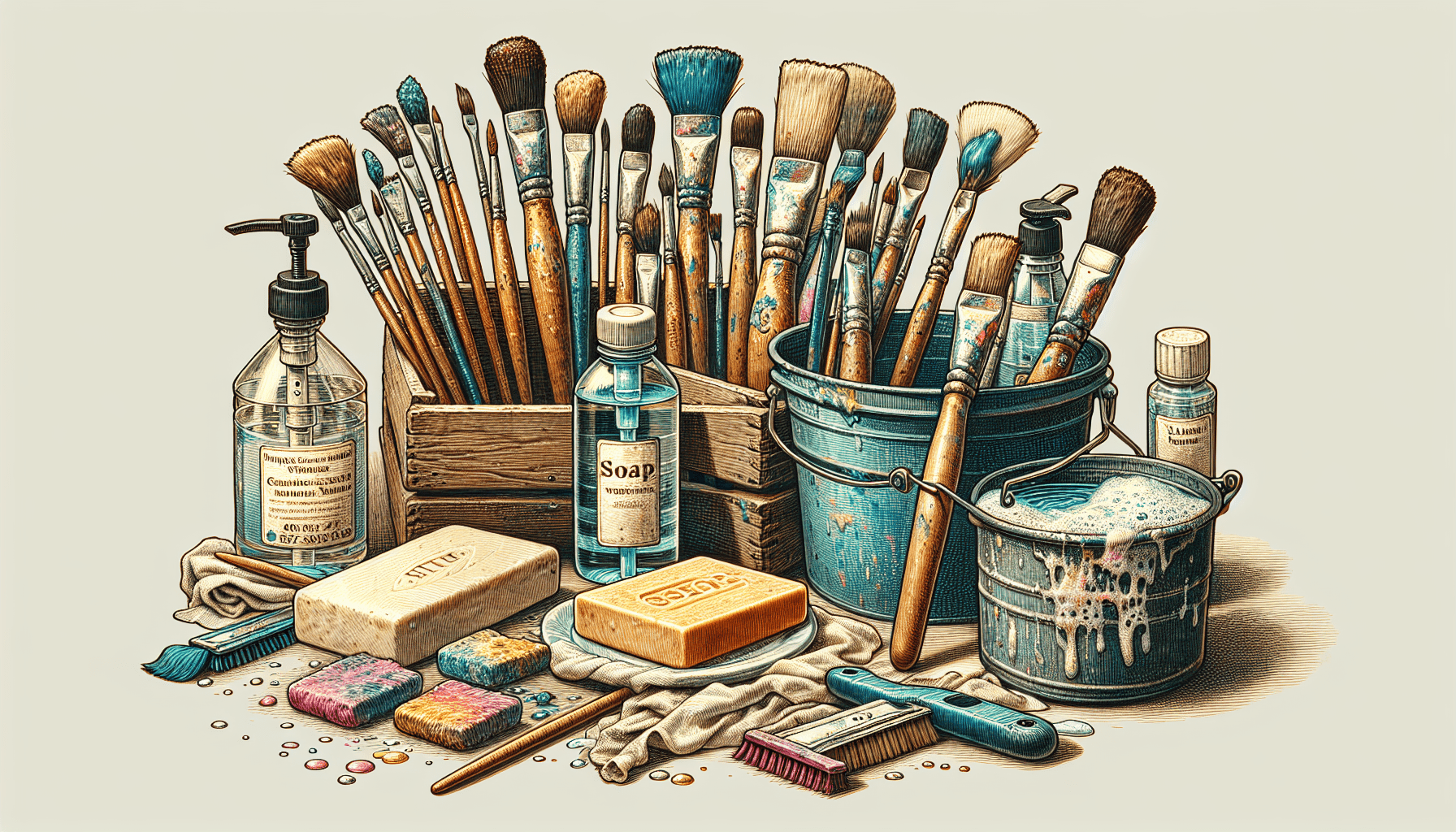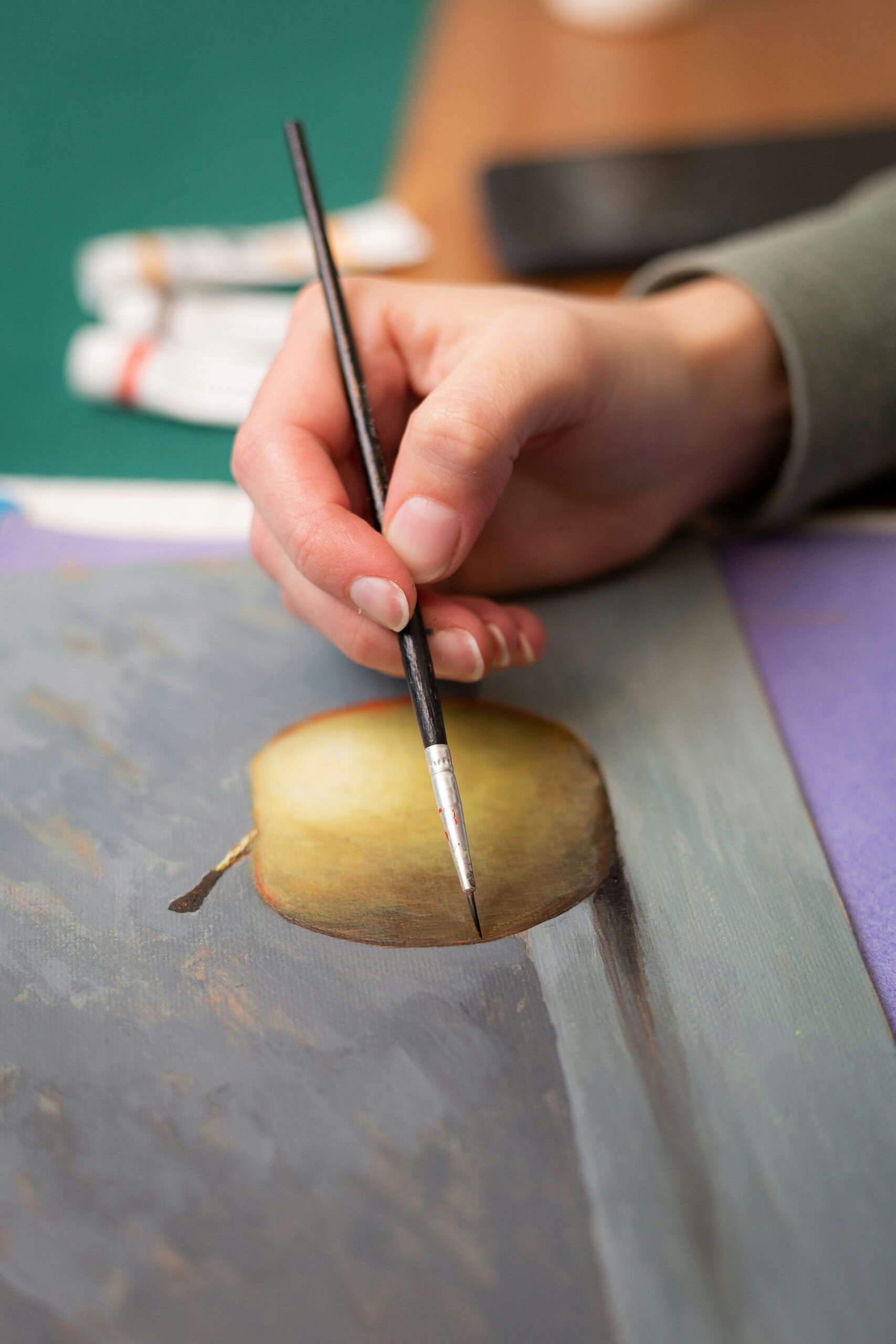In this article, you will discover a step-by-step guide on how to effectively clean paint brushes using mineral spirits. Maintaining the quality and longevity of your paint brushes is essential for any artist or DIY enthusiast, and understanding the proper cleaning method can save you time and money in the long run. By following these simple yet effective techniques, you will be able to efficiently remove paint residues from your brushes, ensuring they remain in pristine condition for future use. So, let’s delve into the world of cleaning paint brushes with mineral spirits and unlock the secrets to preserving your art tools like a true professional.

Gather the Necessary Materials
Before you begin the process of cleaning your paint brushes with mineral spirits, it is important to gather all the necessary materials. Here’s what you’ll need:
Mineral spirits
Mineral spirits, also known as paint thinner, is a solvent that is commonly used to clean paint brushes. It is effective in removing oil-based paints, varnishes, and stains from paint brushes. Make sure to choose a high-quality mineral spirits product for the best results.
A container
You will need a container that is large enough to fully submerge the bristles of your paint brushes. It should also be made of a material that can safely hold the mineral spirits without any leaks or spills. A glass or plastic container with a tight-fitting lid is ideal for this purpose.
Old newspapers or paper towels
To protect your work surface from any drips or spills, it is recommended to cover it with old newspapers or paper towels. These absorbent materials will help in keeping your work area clean and prevent any accidental stains or damage to your surroundings.
Disposable gloves
To protect your hands from coming into direct contact with the mineral spirits or any residual paint, it is advisable to wear disposable gloves. Choose gloves that are durable and chemical-resistant to ensure your safety throughout the cleaning process.
Prepare the Work Area
Now that you have gathered all the necessary materials, it’s time to prepare your work area. Proper preparation will allow you to clean your paint brushes efficiently and avoid any mess or accidents. Follow these steps:
Find a well-ventilated area
To ensure your safety and avoid inhaling any harmful fumes from the mineral spirits, it is important to choose a well-ventilated area for cleaning your paint brushes. Open windows or doors to allow fresh air to circulate, or consider working outdoors if weather permits.
Cover the work surface with old newspapers or paper towels
Before you start cleaning your paint brushes, cover your work surface with old newspapers or paper towels. This will protect your table or countertop from any spills or drips that may occur during the cleaning process. It will also make it easier to clean up once you are finished.
Put on disposable gloves to protect your hands
To protect your hands from coming into contact with the mineral spirits or any residual paint, it is important to wear disposable gloves. Simply put on a pair of gloves before you begin the cleaning process to ensure your hands stay clean and safe throughout.
Remove Excess Paint
Before you can fully clean your paint brushes, it is important to remove any excess paint from the bristles. This will make the overall cleaning process more effective. Follow these steps to remove excess paint:
Scrape off any excess paint from the paintbrush
Using a scraping tool or the edge of a container, gently scrape off any excess paint from the bristles of your paint brush. Be careful not to apply too much pressure, as this could damage the bristles. Continue scraping until you have removed as much paint as possible.
Wipe the brush on the edge of the container to remove additional paint
After scraping off the excess paint, wipe the brush on the edge of the container to remove any additional paint. This motion helps to further clean the bristles and remove any loose paint particles. Continue wiping until the brush appears to be clean and free of paint.
Pour Mineral Spirits
Now that you have removed the excess paint, it’s time to pour the mineral spirits into a container for the cleaning process. Follow these steps:
Fill the container with enough mineral spirits to fully submerge the bristles of the brush
Take your container and carefully pour enough mineral spirits into it to fully submerge the bristles of your paint brush. It is important to ensure that the container is filled with an adequate amount of mineral spirits to effectively clean the brush.

Soak the Brush
Once you have poured the mineral spirits into the container, it’s time to soak the brush. This will allow the solvent to work its magic and break down any remaining paint. Follow these steps:
Place the paintbrush into the container, making sure the bristles are fully immersed in the mineral spirits
Take your paint brush and carefully place it into the container, ensuring that the bristles are fully immersed in the mineral spirits. Make sure that the brush is positioned in a way that allows the bristles to be completely submerged and in contact with the solvent.
Let the brush soak for around 10 minutes
Once the brush is fully submerged in the mineral spirits, allow it to soak for approximately 10 minutes. This soaking time allows the mineral spirits to dissolve any remaining paint and make it easier to clean the brush later on.
Swirl and Agitate
After the brush has soaked in the mineral spirits for the recommended time, it’s time to start the cleaning process. Follow these steps to swirl and agitate the brush:
Gently swirl the brush back and forth in the mineral spirits
Using a gentle swirling motion, move the brush back and forth in the container filled with mineral spirits. This action helps to dislodge any remaining paint particles from the bristles and ensures thorough cleaning. Be careful not to apply too much pressure or be too rough, as this could damage the bristles.
Agitate the bristles against the bottom of the container to help loosen any dried paint
As you swirl the brush, also agitate the bristles against the bottom of the container. This action helps to further loosen any dried and stubborn paint that may be clinging to the bristles. Use a gentle yet effective motion to ensure that the bristles receive a thorough cleaning.
Rinse the Brush
Once you have swirled and agitated the brush in the mineral spirits, it’s time to rinse off any remaining solvent and loosened paint. Follow these steps to rinse your paint brush:
Remove the brush from the container and rinse it under running water
Carefully remove the paint brush from the container filled with mineral spirits and rinse it under running water. This rinse helps to remove any remaining mineral spirits as well as any loosened paint particles from the bristles. Hold the brush under the running water and gently massage the bristles to ensure a thorough rinse.
Use your fingers to gently squeeze out any remaining mineral spirits and loosened paint
After rinsing the brush under running water, use your fingers to gently squeeze out any remaining mineral spirits and loosened paint from the bristles. Starting from the base of the bristles, squeeze and work your way up towards the tip of the brush. Continue squeezing until the bristles feel clean and free of any residue.
Remove Stubborn Paint
If there are still stubborn paint residues clinging to the bristles of your brush, additional steps can be taken to ensure a thorough cleaning. Follow these steps to remove stubborn paint:
If there is still stubborn paint residue, gently brush the bristles against a brush cleaning tool or the edge of the container
If you notice any stubborn paint residue after rinsing the brush, gently brush the bristles against a brush cleaning tool or the edge of the container. This helps to agitate the bristles and loosen any remaining paint particles. Be careful not to apply too much pressure, as this could damage the bristles.
Repeat the swirling and agitating process in the mineral spirits
If the stubborn paint does not come off after brushing, repeat the swirling and agitating process in the mineral spirits. Place the brush back into the container filled with mineral spirits and repeat the swirling and agitating motions. This should help to further loosen any remaining paint and facilitate its removal.
Dry and Store the Brush
Once you have successfully cleaned your paint brush, it is important to properly dry and store it to maintain its quality and extend its lifespan. Follow these steps to dry and store your brush:
Shake off any excess water from the brush
After rinsing the brush and removing any remaining paint or solvent, shake off any excess water from the bristles. Hold the brush upright and gently shake it back and forth to remove any water droplets. This step helps to ensure that the bristles dry properly and avoid any potential damage.
Lay the brush flat on a clean towel or hang it upside down to dry
To allow the brush to dry completely, lay it flat on a clean towel or hang it upside down. Both methods help to prevent any water from collecting at the base of the bristles, which could cause damage or deform the shape of the brush. Ensure that the brush is in a well-ventilated area to promote faster drying.
Once completely dry, store the brush in a clean and dry place
After the brush has fully dried, it is important to store it in a clean and dry place. This helps to prevent any dust, dirt, or debris from accumulating on the bristles and keeps the brush in optimal condition for future use. Store the brush in an upright position or inside a brush holder to maintain its shape and integrity.
Clean the Work Area and Dispose of Mineral Spirits
After completing the cleaning process and ensuring that your paint brushes are properly taken care of, it’s time to clean your work area and dispose of the mineral spirits. Follow these steps to clean up:
Dispose of the mineral spirits according to local regulations
Mineral spirits are considered hazardous waste and should be disposed of properly according to local regulations. Check with your local waste management facility to determine the correct method of disposal for the mineral spirits used in the cleaning process. Do not pour mineral spirits down the drain or throw them in regular trash bins.
Clean the container and any other tools used with soap and water
To clean the container and any other tools used during the cleaning process, simply wash them with soap and water. Use a sponge or brush to scrub off any residue or traces of mineral spirits. Rinse thoroughly and allow the items to dry before storing them.
Dispose of any used newspapers or paper towels
Finally, dispose of any used newspapers or paper towels that were used to cover your work surface. These materials may contain residual paint or solvent, so it is important to dispose of them properly. Check local regulations for proper disposal methods, as they may need to be treated as hazardous waste.
By following these comprehensive steps, you can effectively clean your paint brushes using mineral spirits. Properly maintaining and caring for your paint brushes will not only extend their lifespan but also ensure optimal performance in your future painting endeavors. Remember to always prioritize safety and follow local regulations when handling and disposing of hazardous materials.



